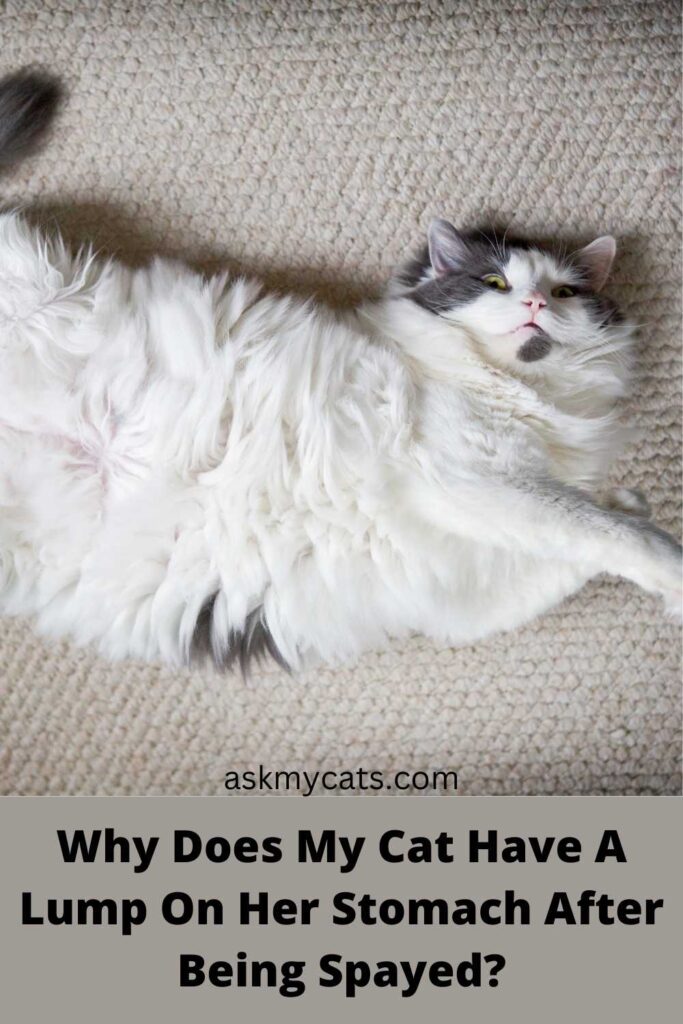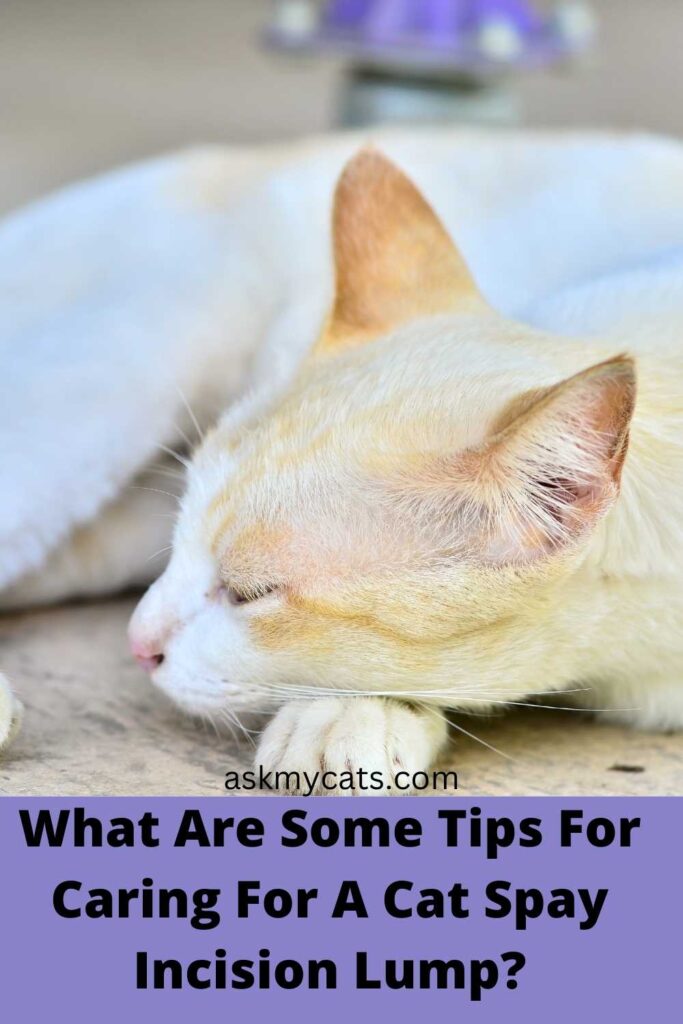Congratulations on getting your cat spayed!
You are caring for numerous kittens from being homeless, and that is a great job.
Although spaying cats is mostly a safe surgery, occasional difficulties may occur. It heavily depends on the veterinarian’s approach, the type of sutures used, and the patient’s personal medical history.
Before you allow this operation to take place, consider the potential symptoms.
I know you are worried about seeing a lump on your cat’s stomach after her surgery, and I am here to relieve you of your stress.
In this article, you’ll find answers to questions such as “Do cats typically get a lump post-operation?” and “How to take care of cats after being spayed?”
Let’s get into it.


Give Your Cat the Perfect Day
Get the Free Ebook!
Is It Normal For My Cat To Have A Lump After Being Spayed?
Let’s get this straight- NO, your cat is not supposed to get any lumps post-surgery but it is not uncommon if they get one.
Contact your veterinarian as soon as you can if you see a lump close to your cat’s surgical site; they are the best source to find the cause.
However, there may occasionally be redness or a greenish-yellow discharge close to the incision.
Even while the lump might be a typical reaction, you should be aware of odd symptoms, such as its propensity to expand, the occurrence of another swelling, or the warmth of her skin.
Additionally, watch out for any indicators of pain, fatigue, or a lack of appetite.
Why Does My Cat Have A Lump On Her Stomach After Being Spayed?

A week or a few days following surgery, a small, barely noticeable swelling under the incision develops. The body is simply working on the sutures with this suture reaction. Only a small percentage of animals react, and these lumps typically take several days to go away.
Here are some possible reasons for your cat to get a lump:
1. Stitches
It can just be the knot of the sutures if you notice a little lump at one end of the incision. If there are sutures on your cat, you are only viewing the outer layer.
A few layers are involved in surgical closure. The vet starts by stitching up the body wall. The connective tissue between the body wall and the skin is then sealed off.
The next layer is the skin closure, which may be completed so that no sutures are visible since tissue glue may be used to assist in sealing the skin there. The sutures must still be fixed in place, though. Vets tie a knot to accomplish this.
This knot is frequently buried to keep it out of a self-grooming cat’s reach. This knot could appear under the skin as a concerning bulge. As long as it isn’t red, itchy, leaking, or painful, it might not be a serious problem.
Must Read: Why Is My Spayed Cat Pulling Out Her Stitches?
2. Tissues
The body generates scar tissue as injuries recover. It may resemble an atypical lump if there is an overabundance of scar tissue.
Scar tissue often has a stiff, ropy texture to it. There shouldn’t be any discomfort or fluid leakage.
3. Hernia
After abdominal surgery, if you see a bulge on your cat’s tummy, you could be concerned that it’s a hernia.
The size of umbilical hernias can range from barely noticeable to extremely noticeable. They could include intestines or belly fat, depending on how bad the condition is.
These hernias, which are the most common ones in cats, develop when the abdominal wall is damaged.
Although they may be undetectable, when the cat gets on all fours, a bubble-like enlargement might be visible as fat or intestines move into this “pocket.”
4. Fluids
When the body experiences a slight reaction to the suture material, mild to major edema may happen. A seroma, commonly known as a buildup of fluid, may result from this.
However, the fluid may contain pus, which is a sign of inflammation if your cat is developing an illness.
You should consult your veterinarian if you notice a lump that is growing larger, is warm or heated to the touch, or is gushing fluid. Your cat may require antibiotics or other treatments.
Interesting Read: Why Are My Cat’s Sides Sunken After She Has Been Spayed?
What Are The Types Of Cat Spay Incision Lumps?

Here are some of the lumps that cats may get after being spayed:
1. Abscesses
An abscess is a fluid-filled swelling that develops between the muscles and skin of the abdominal wall.
The subcutaneous cavity wasn’t sterile; bacteria had entered it and filled it with pus that ranged in color from cream to brown.
Abscesses are red or black in hue, and they are hot and uncomfortable to touch. Abscesses will enlarge and eventually burst through the suture line if left untreated, causing wound disintegration.
Cats need special care from a veterinarian because they won’t shrink on their own.
Antibiotics and surgical abscess drainage are required to treat the issue.
2. Seromas
A seroma is a significant lump that develops after surgery when the subcutaneous fat layer is ruptured, as in the center of a cat’s abdomen.
This results from either the medical procedure or the animal excessively licking the incision site. Alternatively, if the cat moves about excessively, seromas may also develop.
Seromas often shrink with time and don’t need any special care. You can give your kitty buddy pain relievers, restrict mobility, stop her from licking, and apply cold compresses to the lump to lessen discomfort.
3. Hernias
A hernia is a specific type of bulge that develops after a spay incision when the animal’s abdominal wall sutures fail, allowing fat, intestines, and other internal organs to protrude from the abdominal cavity and into the area beneath the skin.
The most common form of treatment for this illness is surgery. If the bladder emerges through the hernial ring or a section of the bowel becomes strangulated, immediate surgical repair is required.
Animals suffering from strangulated bowels or imprisoned bladders are extremely unwell, so pay attention to their diagnosis.
Interesting Read: Why Does My Cat Have A Saggy Belly After Being Spayed?
What Are Some Tips For Caring For A Cat Spay Incision Lump?

Limit Their Activities
You should try to keep your cat from moving about as much while she recovers fully from the operation.
The incision may become more visible if you move too much. When you won’t be able to keep an eye on her behavior, try to keep her in a room with plenty of space or a carrier that is quiet.
Additionally, keep your home serene to provide your kitty companion with a cozy living space.
Must Read: How Long Should I Confine My Cat In An Enclosed Area After Spay?
Rearrange Her Hiding Spots
Cats have a natural tendency to hide after upsetting occurrences like surgery. You cannot effectively watch them in this situation.
As a result, do your best to keep them away from possible hiding spots like closets or the basement. Use collars with bells attached to let you know where they are at all times.
Interesting Read: Why Is My Cat Hiding After Being Spayed?
Don’t Let Them Lick Themselves
Cats groom themselves frequently, yet a lot of bacteria live in their mouths. As a result, you shouldn’t ever allow the cat to lick the surgical wound.
During the healing period, you can use the cone or an E-collar, if necessary. She won’t be used to it at first, but she will become used to it.
Prevent Bathing
In an effort to minimize bacterial contamination, cat owners frequently give their pets a bath. The opposite, however, is accurate.
Water may cause the incision to enlarge during the healing process, delaying the healing of the wound.
Interesting Read: Can I Bathe My Cat After Neutering Or Spaying?
Vet! Vet! Vet!
You should carefully follow the veterinarian’s instructions because it’s likely that she will advise home treatment or pain medication for your cat.
Do not administer any human medications to her or apply creams or ointments to the incision site.
If anything strange happens or you notice that she isn’t getting any better, call the vet right away to switch to the proper course of action. Examine the incision site twice daily to spot any changes and check for edema or drainage.
Frequently Asked Questions
Does every cat get a lump after they are spayed?
Feline spaying is a surgical procedure often performed by a veterinarian that removes the reproductive system of female cats. The fallopian system, uterus, and ovaries were removed.
Spaying a pet, especially a cat, is a common practice in pet care because it reduces pet overpopulation and guards against potential health and behavioral issues, allowing the animal to live a long and healthy life.
However, not all spaying procedures result in your cat’s return to normalcy. She can experience side effects from the surgery, such as lumps developing close to the incision. To determine the best treatments, you must study the cat spay incision lumps.
Final Words
That’s all you had to know about spayed cats, their post-operative incisions, and the ways to look after them so that your furbaby can heal even faster.
Let us know in the comments section if your cat got an incision post-surgery. How did you look after her? How much time did she take to recover?
Must Read: How To Tell If My Cat Is In Pain After Spay?
